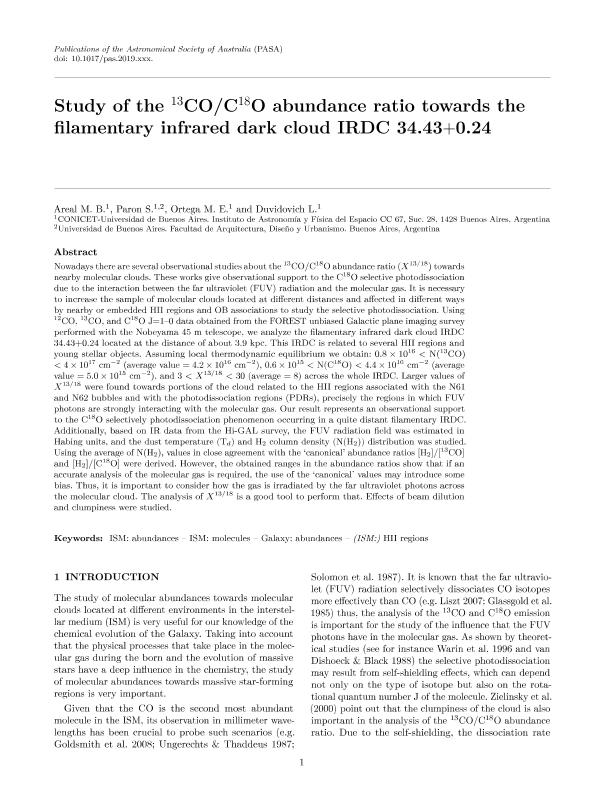Artículo
Study of the 13CO/C18O abundance ratio towards the filamentary infrared dark cloud IRDC 34.43 + 0.24
Fecha de publicación:
11/2019
Editorial:
Cambridge University Press
Revista:
Publications Of The Astronomical Society Of Australia
ISSN:
1323-3580
Idioma:
Inglés
Tipo de recurso:
Artículo publicado
Clasificación temática:
Resumen
Nowadays, there are several observational studies about the 13CO/C18O abundance ratio ( $X^{13/18}$ ) towards nearby molecular clouds. These works give observational support to the C18O selective photodissociation due to the interaction between the far ultraviolet (FUV) radiation and the molecular gas. It is necessary to increase the sample of molecular clouds located at different distances and affected in different ways by nearby or embedded H ii regions and OB associations to study the selective photodissociation. Using 12CO, 13CO, and C18O J = 1-0 data obtained from the FOREST unbiased Galactic plane imaging survey performed with the Nobeyama 45-m telescope, we analyse the filamentary infrared dark cloud IRDC $34.43+0.24$ located at the distance of about 3.9 kpc. This infrared dark cloud (IRDC) is related to several H ii regions and young stellar objects. Assuming local thermodynamic equilibrium, we obtain: $0.8 imes 10^{16} <$ N(13CO) $<4 imes 10^{17}$ cm-2 (average value $= 4.2 imes 1016$ cm-2), $0.6 imes 10^{15} <$ N(C18O) $<4.4 imes 10^{16}$ cm-2 (average value $= 5.0 imes 10^{15}$ cm-2), and 3 $<$ $X^{13/18}$ $<$ 30 (average $= 8$ ) across the whole IRDC. Larger values of $X^{13/18}$ were found towards portions of the cloud related to the H ii regions associated with the N61 and N62 bubbles and with the photodissociation regions, precisely the regions in which FUV photons are strongly interacting with the molecular gas. Our result represents an observational support to the C18O selectively photodissociation phenomenon occurring in a quite distant filamentary IRDC. Additionally, based on IR data from the Hi-GAL survey, the FUV radiation field was estimated in Habing units, and the dust temperature (T ${dust}$ ) and H2 column density (N(H2)) distribution were studied. Using the average of N(H2), values in close agreement with the 'canonical' abundance ratios [H2]/[13CO] and [H2]/[C18O] were derived. However, the obtained ranges in the abundance ratios show that if an accurate analysis of the molecular gas is required, the use of the 'canonical' values may introduce some bias. Thus, it is important to consider how the gas is irradiated by the FUV photons across the molecular cloud. The analysis of $X^{13/18}$ is a good tool to perform that. Effects of beam dilution and clumpiness were studied.
Palabras clave:
(ISM:) H II REGIONS
,
GALAXY: ABUNDANCES
,
ISM: ABUNDANCES
,
ISM: MOLECULES
Archivos asociados
Licencia
Identificadores
Colecciones
Articulos(IAFE)
Articulos de INST.DE ASTRONOMIA Y FISICA DEL ESPACIO(I)
Articulos de INST.DE ASTRONOMIA Y FISICA DEL ESPACIO(I)
Citación
Areal, María Belén; Paron, Sergio Ariel; Ortega, Martin Eduardo; Duvidovich, Laura Patricia; Study of the 13CO/C18O abundance ratio towards the filamentary infrared dark cloud IRDC 34.43 + 0.24; Cambridge University Press; Publications Of The Astronomical Society Of Australia; 11-2019; 1-10
Compartir
Altmétricas




